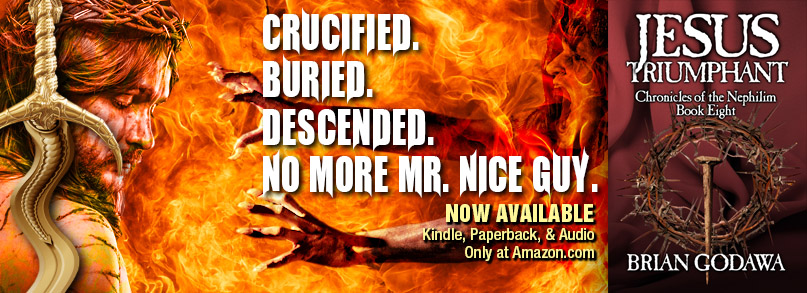One of the most difficult and strange passages in the New Testament is 1 Peter 3:18-22. It’s oddity approaches that of Genesis 6:1-4 that speaks of the Sons of God mating with the daughters of men in the days of Noah and breeding Nephilim giants that lead to the judgment of the Flood.
Perhaps its oddity is tied to the fact that it is most likely connected directly to Genesis 6 and therefore of particular importance for the Biblical Cosmic War of the Seed.This 1 Peter 3 passage is notorious for its difficult obscurity and lack of consensus among scholarly interpretation. Views are divided over it with a variety of speculative interpretations to pick from. So, let’s take a look at it more closely with an attempt to clarify its meaning.
1 Peter 3:18–22
For Christ also suffered once for sins, the righteous for the unrighteous, that he might bring us to God, being put to death in the flesh but made alive in the spirit, in which he went and proclaimed to the spirits in prison, because they formerly did not obey, when God’s patience waited in the days of Noah, while the ark was being prepared, in which a few, that is, eight persons, were brought safely through water. Baptism, which corresponds to this, now saves you, not as a removal of dirt from the body but as an appeal to God for a good conscience, through the resurrection of Jesus Christ, who has gone into heaven and is at the right hand of God, with angels, authorities, and powers having been subjected to him.
The context of this letter is the suffering of believers for their faith under the persecution of the Roman empire (3:13-17). Peter is encouraging them to persevere in doing good despite the evil done against them because they will be a witness to the watching world just as Christ was in his suffering. He then launches into this section as an analogy of what Christ did for us in his journey of suffering, death, resurrection, and ascension.The questions begin to pile up:
When did Christ go on this journey? (v. 18)
Who are the spirits? (v. 19)
Where did he go to proclaim to the spirits? (v. 19)
What did he proclaim? (v. 19)
Where is this prison that they are in? (v. 19)
I believe the answers to these questions are very much in line with the storyline of the War of the Seed. I will try to answer the first three in this post and tackle the last two in the next one.
When Did Christ Go on His Journey?
When Christ “went” to proclaim to the spirits in prison, it says he was “put to death in the flesh but made alive in the spirit, in which he went…” In the original Greek, “he went” does not contain a notion of direction as in ascent to heaven or descent to hell. It can only be determined by the context.[1] So let’s look at that context.Some scholars interpret this being “made alive in the spirit” as a reference to the physical resurrection of Christ from the dead, repeated later in v. 21. As Bible commentator Ramsey Michaels says, “the distinction here indicated by “flesh” and “Spirit” is not between the material and immaterial parts of Christ’s person (i.e., his “body” and “soul”), but rather between his earthly existence and his risen state.”[2]
Scholar William Dalton argues that the idea of being made alive in the spirit was a New Testament reference to the resurrection of Christ’s physical body by the power of the Holy Spirit, not a reference to Christ’s disembodied soul.[3] He writes, “General New Testament anthropology insists on the unity of the human person. Terms such as “flesh” and “spirit” are aspects of human existence, not parts of a human compound. Bodily resurrection is stressed, not the immortality of the soul.”[4]This venerable interpretation sees Christ proclaiming to the spirits as a resurrected body, sometime before he ascended.
Another scholarly interpretation is that Christ’s journey of proclamation occurred in a disembodied state between his death and resurrection. While his body was dead for three days, his spirit was alive and in Sheol. This understands the flesh/spirit distinction as a conjunction of opposites. “Put to death in the flesh but made alive in the spirit” is not talking about the fleshly death and fleshly resurrection, but a fleshly death and a spiritual life. The “spirit” in which he was made alive in this view is not the Holy Spirit, but rather his disembodied soul in the spiritual realm. That “spirit” then corresponds to the “spirits” to whom he proclaimed in the very next verse (v. 19).
This view that Christ’s soul or spirit went down into the underworld of Sheol between his death and resurrection is the most ancient and most traditional view, as attested in the Apostle’s Creed.[5] The Greek for “made alive” is never used of Christ’s physical resurrection in the New Testament, but it is used of the spiritual reality of the believer “being made alive” in Christ (Eph. 2:5-6).[6]Christ suffered the spiritual death of separation from the Father when he died on the cross (Isa. 53:4-6; 1 Pet. 2:24; Matt. 27:46). How the second person of the Trinity can experience separation from the Father remains a Biblical mystery. But in this interpretation, it is Christ’s disembodied spirit that makes the journey to proclaim to the spirits, not his resurrected body.
But whether Christ proclaims in his resurrected body or in his immaterial spirit, the next question arises, who are the spirits to which he proclaims and where are they?
This will be fascinating to you… Continue reading













